Tunable Spatial Resolution Focused Laser Differential Interferometer for Density Fluctuation Measurement
Abstract
1. Introduction
2. Materials and Methods
3. Results and Discussion
3.1. Device Calibration
3.2. Shear Flow Device
3.3. Density Fluctuation Measurement
4. Conclusions
Author Contributions
Funding
Institutional Review Board Statement
Informed Consent Statement
Data Availability Statement
Conflicts of Interest
References
- Tagawa, M.; Ohta, Y. Two-thermocouple probe for fluctuating temperature measurement in combustion—Rational estimation of mean and fluctuating time constants. Combust. Flame 1997, 109, 549–560. [Google Scholar] [CrossRef]
- Sanderson, S.R.; Sturtevant, B. Transient heat flux measurement using a surface junction thermocouple. Rev. Sci. Instrum. 2002, 73, 2781–2787. [Google Scholar] [CrossRef]
- Preston, J.H. The Determination of Turbulent Skin Friction by Means of Pitot Tubes. J. R. Aeronaut. Soc. 1954, 58, 109–121. [Google Scholar] [CrossRef]
- Nguyen, D.T.; Choi, Y.M.; Lee, S.H.; Kang, W. The impact of geometric parameters of a S-type Pitot tube on the flow velocity measurements for greenhouse gas emission monitoring. Flow Meas. Instrum. 2019, 67, 10–22. [Google Scholar] [CrossRef]
- Charogiannis, A.; An, J.S.; Voulgaropoulos, V.; Markides, C. Structured planar laser-induced fluorescence (S-PLIF) for the accurate identification of interfaces in multiphase flows. Int. J. Multiph. Flow 2019, 118, 193–204. [Google Scholar] [CrossRef]
- Li, F.; Yang, H.; Zhang, J.; Gu, C.; Huo, J.; Jiang, L.; Wang, X.; Zhao, D. OH-PLIF investigation of Y2O3-ZrO2 coating improving flame stability in a narrow channel. Chem. Eng. J. 2021, 405, 126708. [Google Scholar] [CrossRef]
- Hsu, P.S.; Jiang, N.; Felver, J.J.; Lauriola, D.K.; Danehy, P.M.; Roy, S. 10 kHz two-color OH PLIF thermometry using a single burst-mode OPO. Opt. Lett. 2021, 46, 2308–2311. [Google Scholar] [CrossRef]
- Parziale, N.J.; Jewell, J.S.; Shepherd, J.E.; Hornung, H.G. Shock tunnel noise measurement with resonantly enhanced focused schlieren deflectometry. In Proceedings of the 28th International Symposium on Shock Waves, Manchester, UK, 17–22 July 2012; Springer: Berlin/Heidelberg, Germany, 2012; pp. 747–752. [Google Scholar]
- Wang, D.; Zhao, Y.; Xia, Z.; Wang, Q.; Huang, X. Multi-resolution analysis of density fluctuation of coherent structures about supersonic flow over vg. Chin. J. Aeronaut. 2012, 25, 173–181. [Google Scholar] [CrossRef]
- Benitez, E.K.; Jewell, J.S.; Schneider, S.P. Focused laser differential interferometry for hypersonic flow instability measurements with contoured tunnel windows. In Proceedings of the AIAA Scitech 2020 Forum, Orlando, FL, USA, 6–10 January 2020; p. 1282. [Google Scholar]
- Settles, G.S.; Fulghum, M.R. The Focusing Laser Differential Interferometer, an Instrument for Localized Turbulence Measurements in Refractive Flows. J. Fluids Eng. 2016, 138, 101402. [Google Scholar] [CrossRef]
- Price, T.J.; Gragston, M.; Schmisseur, J.D.; Kreth, P.A. Measurement of supersonic jet screech with focused laser differential interferometry. Appl. Opt. 2020, 59, 8902–8908. [Google Scholar] [CrossRef]
- Yu, T.; Xiong, Y.; Zhao, J.; Wu, J. Application of focused laser differential interferometer to hypersonic boundary-layer instability study. Chin. J. Aeronaut. 2021, 34, 17–26. [Google Scholar] [CrossRef]
- Bathel, B.F.; Herring, G.C.; Weisberger, J.M.; Chou, A.; Jones, S.B. Simultaneous focused laser differential interferometry and high-speed schlieren in a Mach 6 flow. Meas. Sci. Technol. 2021, 32, 095907. [Google Scholar] [CrossRef]
- Lawson, J.M.; Austin, J.M. Focused laser differential interferometer response to shock waves. Meas. Sci. Technol. 2021, 32, 055203. [Google Scholar] [CrossRef]
- Smeets, G. Laser Interferometer for High Sensitivity Measurements on Transient Phase Objects. IEEE Trans. Aerosp. Electron. Syst. 1972, AES-8, 186–190. [Google Scholar] [CrossRef]
- Smeets, G.; George, A. Gas-Dynamic Investigations in a Shock Tube Using a Highly Sensitive Interferometer; Institut Franco-Allemand de Recherches: Saint-Louis, France, 1996. [Google Scholar]
- Smeets, G.; George, A. Laser-Differential Interferometer Applications in Gas Dynamics; Institut Franco-Allemand de Recherches: Saint-Louis, France, 1996. [Google Scholar]
- Smeets, G. Flow diagnostics by laser interferometry. IEEE Trans. Aerosp. Electron. Syst. 1977, 2, 82–90. [Google Scholar] [CrossRef]
- Parziale, N.J.; Shepherd, J.E.; Hornung, H.G. Differential Interferometric Measurement of Instability in a Hypervelocity Boundary Layer. AIAA J. 2013, 51, 750–754. [Google Scholar] [CrossRef]
- Xiong, Y.; Yu, T.; Lin, L.; Zhao, J.; Wu, J. Nonlinear Instability Characterization of Hypersonic Laminar Boundary Layer. AIAA J. 2020, 58, 5254–5263. [Google Scholar] [CrossRef]
- Birch, B.; Buttsworth, D.; Zander, F. Measurements of freestream density fluctuations in a hypersonic wind tunnel. Exp. Fluids 2020, 61, 158. [Google Scholar] [CrossRef]
- Lawson, J.M.; Neet, M.C.; Grossman, I.J.; Austin, J.M. Static and dynamic characterization of a focused laser differential interferometer. Exp. Fluids 2020, 61, 187. [Google Scholar] [CrossRef]
- Ceruzzi, A.; Neisess, C.; McManamen, B.; Cadou, C.P. Investigation of Focused Laser Differential Interferometry (FLDI) Sensitivity Function. In Proceedings of the AIAA Scitech 2021 Forum, virtual, 11–15 & 19–21 January 2021; p. 1299. [Google Scholar]
- Jewell, J.S.; Hameed, A.; Parziale, N.J.; Gogineni, S.P. Disturbance speed measurements in a circular jet via double focused laser differential interferometry. In Proceedings of the AIAA Scitech 2019 Forum, San Diego, CA, USA, 7–11 January 2019; p. 2293. [Google Scholar]
- Ceruzzi, A.; Cadou, C.P. Simultaneous velocity and density gradient measurements using two-point focused laser differential interferometry. In Proceedings of the AIAA Scitech 2019 Forum, San Diego, CA, USA, 7–11 January 2019; p. 2295. [Google Scholar]
- Bathel, B.F.; Weisberger, J.M.; Herring, G.C.; King, R.A.; Jones, S.B.; Kennedy, R.E.; Laurence, S.J. Two-point, parallel-beam focused laser differential interferometry with a Nomarski prism. Appl. Opt. 2020, 59, 244–252. [Google Scholar] [CrossRef]
- Ceruzzi, A.; Callis, B.; Weber, D.; Cadou, C.P. Application of focused laser differential interferometry (FLDI) in a supersonic boundary layer. In Proceedings of the AIAA Scitech, Orlando, FL, USA, 6–10 January 2020; p. 1973. [Google Scholar]
- Schmidt, B.E.; Shepherd, J. Analysis of focused laser differential interferometry. Appl. Opt. 2015, 54, 8459–8472. [Google Scholar] [CrossRef] [PubMed]
- Gutmark, E.J.; Schadow, K.C.; Yu, K.H. Mixing enhancement in supersonic free shear flows. Annu. Rev. Fluid Mech. 1995, 27, 375–417. [Google Scholar] [CrossRef]
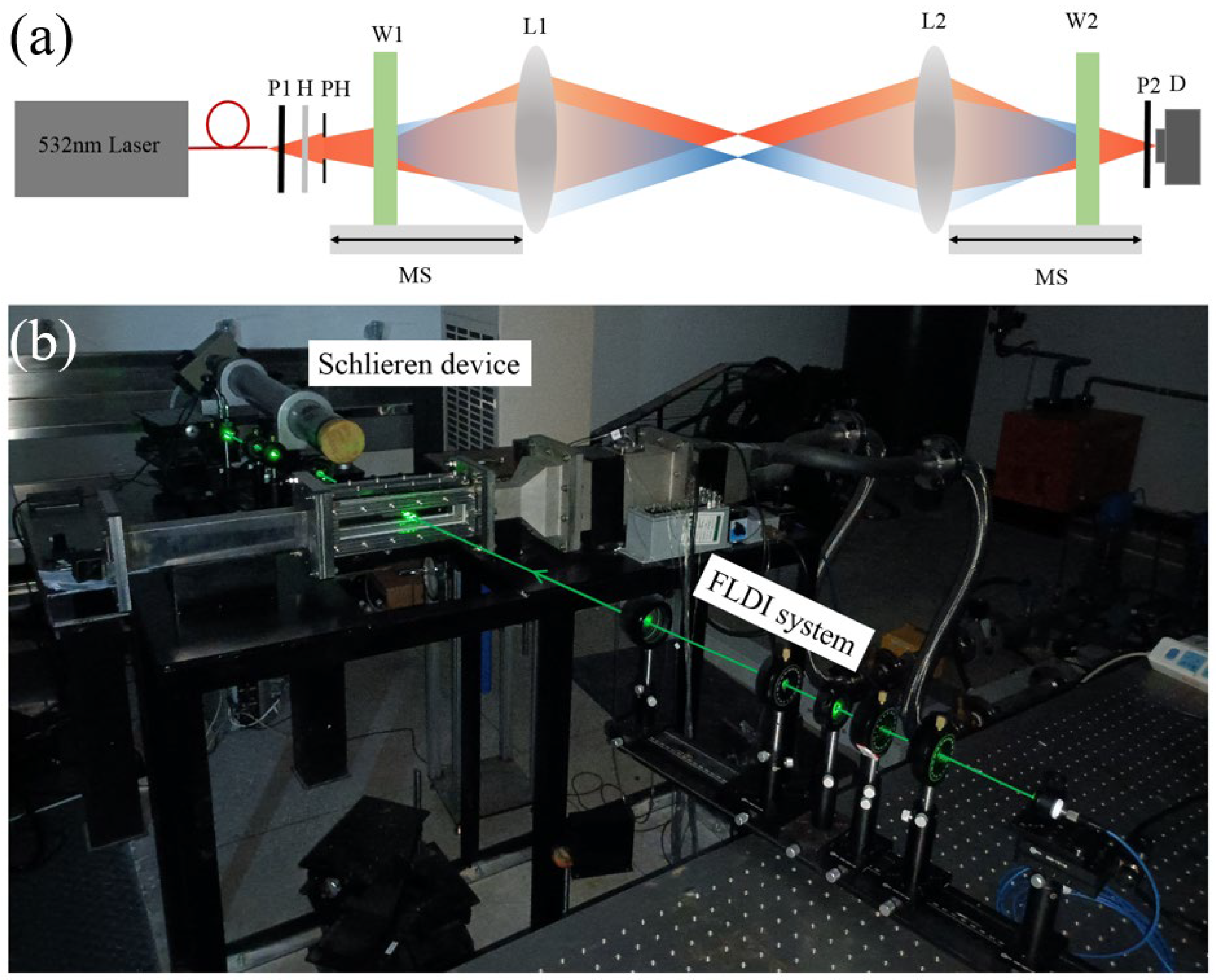
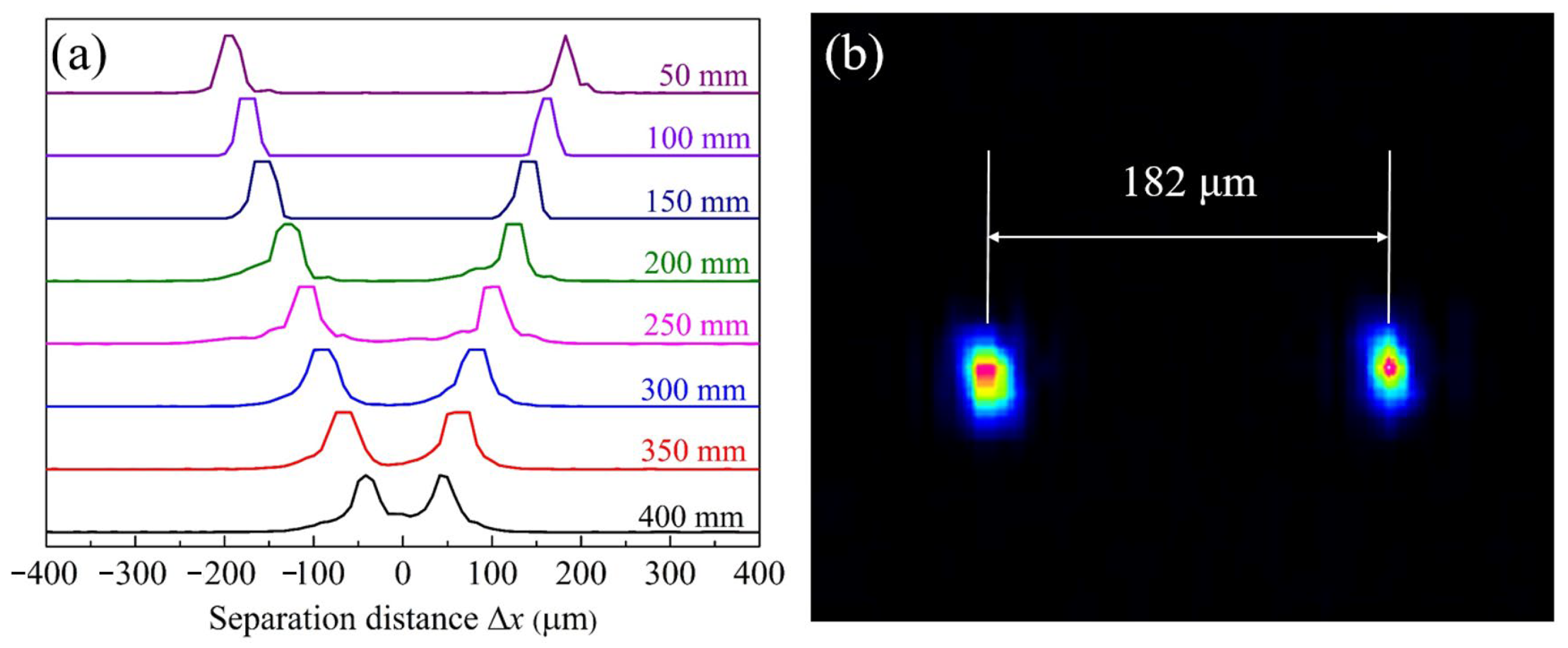
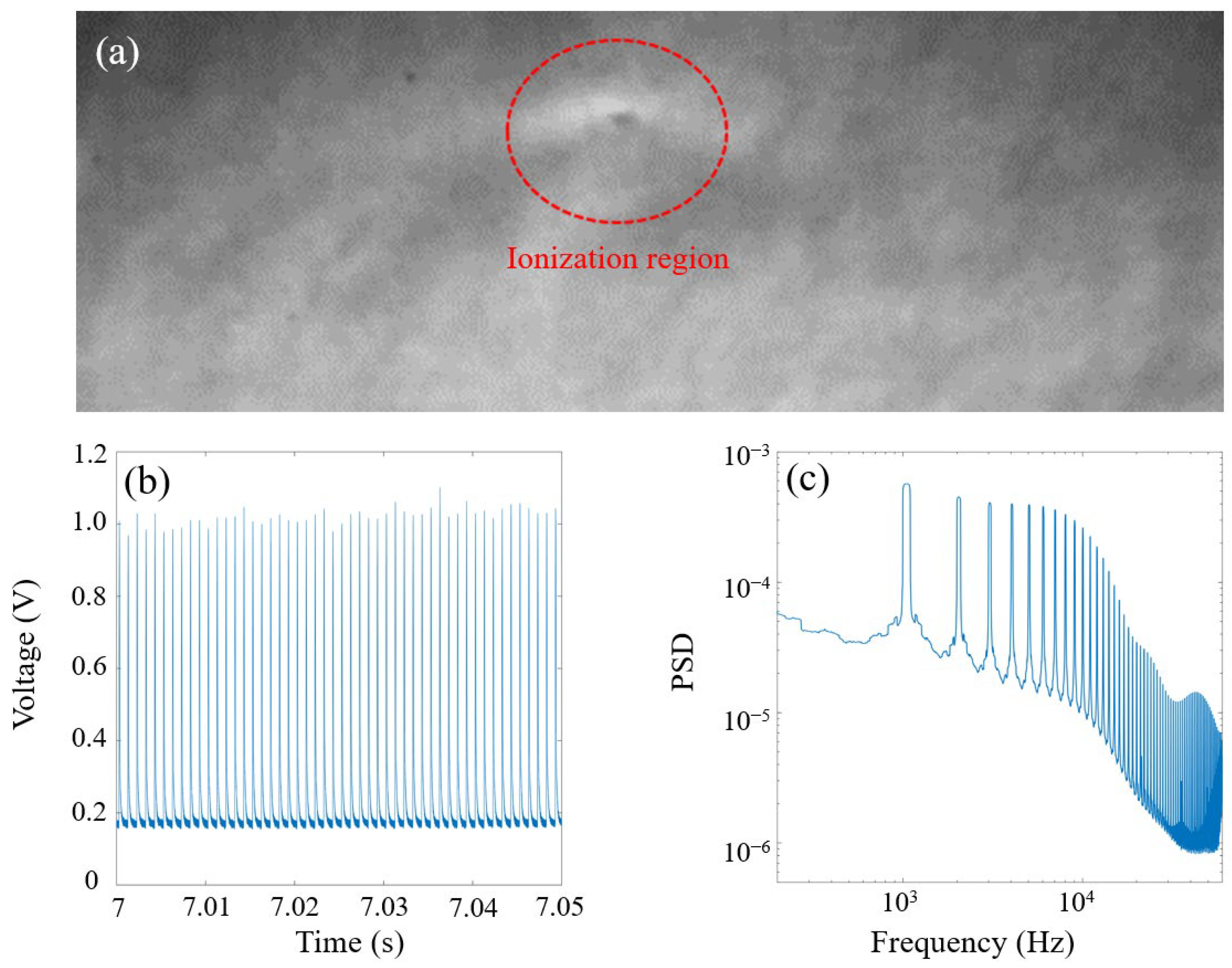
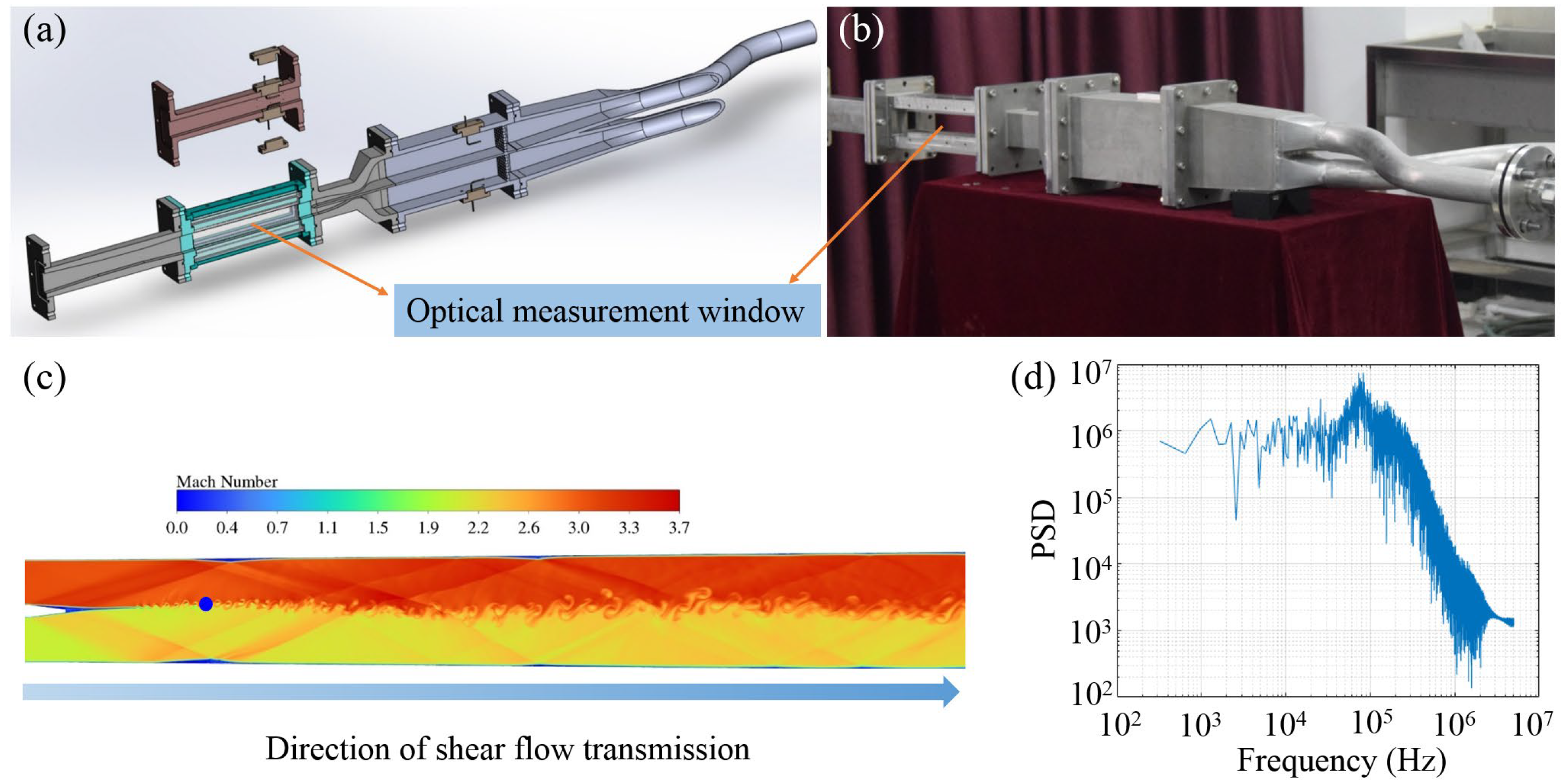
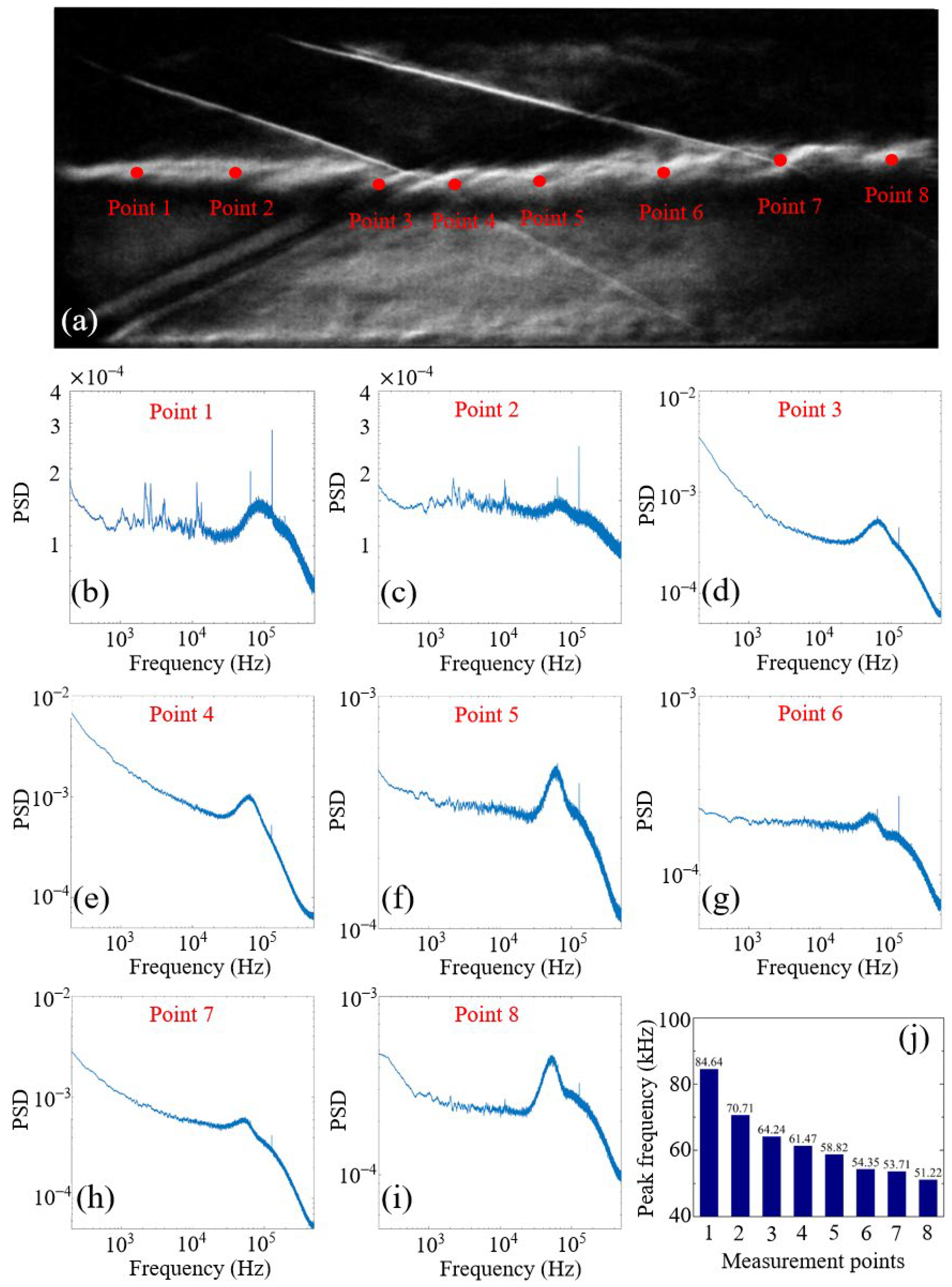
Disclaimer/Publisher’s Note: The statements, opinions and data contained in all publications are solely those of the individual author(s) and contributor(s) and not of MDPI and/or the editor(s). MDPI and/or the editor(s) disclaim responsibility for any injury to people or property resulting from any ideas, methods, instructions or products referred to in the content. |
© 2023 by the authors. Licensee MDPI, Basel, Switzerland. This article is an open access article distributed under the terms and conditions of the Creative Commons Attribution (CC BY) license (https://creativecommons.org/licenses/by/4.0/).
Share and Cite
Li, H.; Li, Y.; Chen, L.; Yao, X. Tunable Spatial Resolution Focused Laser Differential Interferometer for Density Fluctuation Measurement. Appl. Sci. 2023, 13, 3253. https://doi.org/10.3390/app13053253
Li H, Li Y, Chen L, Yao X. Tunable Spatial Resolution Focused Laser Differential Interferometer for Density Fluctuation Measurement. Applied Sciences. 2023; 13(5):3253. https://doi.org/10.3390/app13053253
Chicago/Turabian StyleLi, Hongxun, Yudong Li, Li Chen, and Xianghong Yao. 2023. "Tunable Spatial Resolution Focused Laser Differential Interferometer for Density Fluctuation Measurement" Applied Sciences 13, no. 5: 3253. https://doi.org/10.3390/app13053253
APA StyleLi, H., Li, Y., Chen, L., & Yao, X. (2023). Tunable Spatial Resolution Focused Laser Differential Interferometer for Density Fluctuation Measurement. Applied Sciences, 13(5), 3253. https://doi.org/10.3390/app13053253




